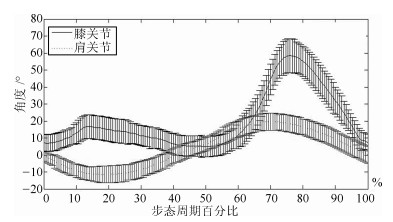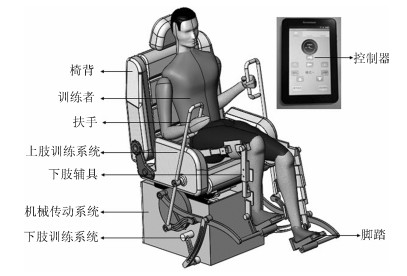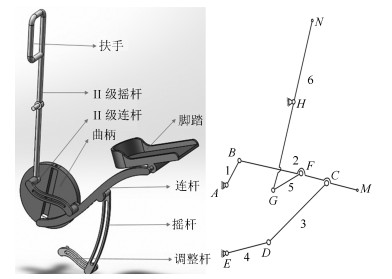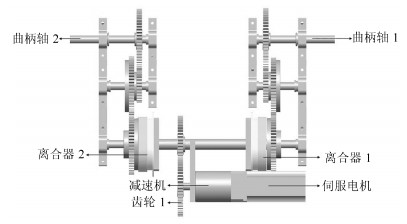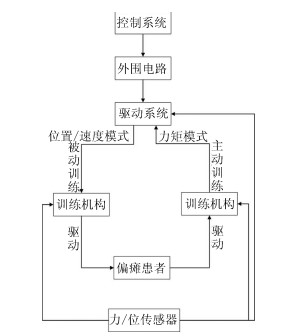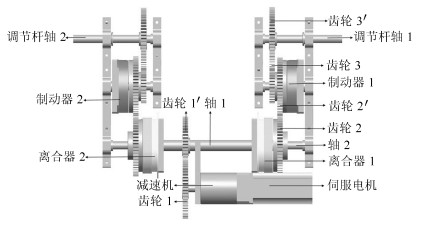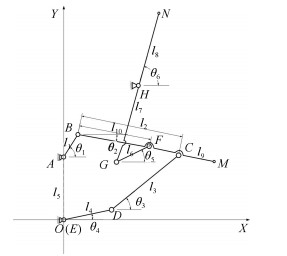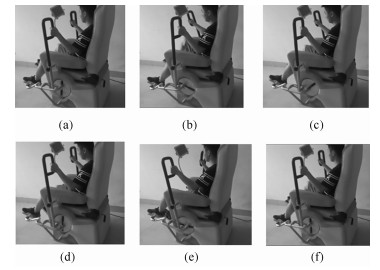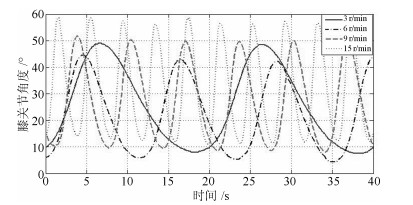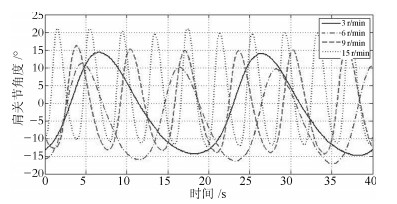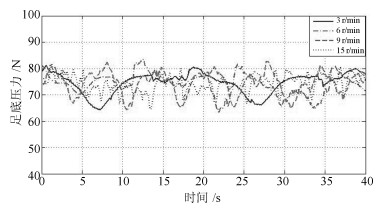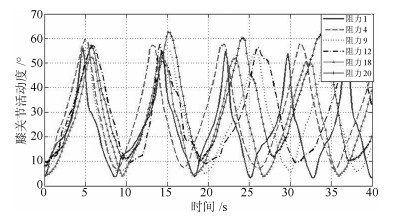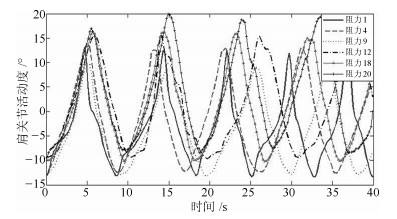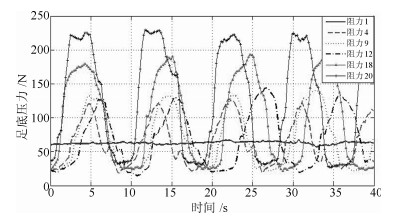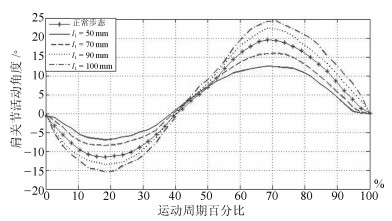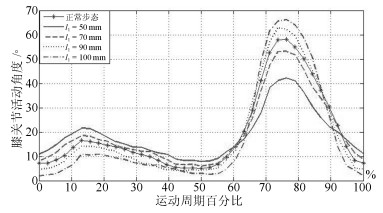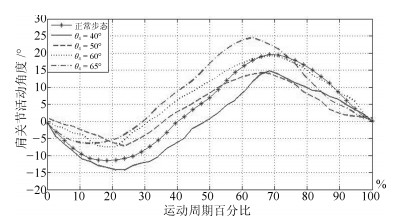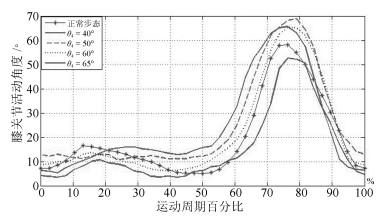Mechanism Design and Experiment of Rehabilitation Training Robot for Coordinated Movement of Upper and Lower Limbs
-
摘要: 针对临床上缺少一种肢体协调运动康复训练设备的现状,研制了一款适用于偏瘫患者个性化训练的上下肢协调运动康复机器人.首先,在探究正常步态上下肢协调运动规律的基础上,选择以肩、膝关节角度协调变化规律作为机器人的设计目标;然后,基于五杆变胞机构设计了康复训练机构及主/辅传动链,并对训练机构进行了运动学分析;最后,在样机上进行了实验,结果表明该机器人能够满足设计目标.Abstract: Owing to the lack of clinic rehabilitation training equipment for coordinated movement, a rehabilitation robot for upper and lower limbs coordination movement is developed, which is suitable for individualized training of hemiplegia patients. Firstly, the regularity of human shoulder and knee angle coordination movement is identified as a design objective based on normal gait of coordination movement of upper and lower limbs. Then, the rehabilitation training mechanism and the main or auxiliary drive chain based on a five-bar metamorphic mechanism are designed, and kinematic analysis of training mechanism is carried out. Finally, tests on the prototype are carried out, and the results show that the robot can achieve the design goal.1) 本文责任编委 王启宁
-
表 1 机器人主要参数
Table 1 Robot main parameters
名称 参数 名称 参数 椅宽 860 mm 调步长范围 200~600 mm 椅高 500 mm 肩关节范围 -15°~20° 椅面位移 0~140 mm 膝关节范围 10°~60° 座椅靠背角 90°~150° 调整杆角范围 10°~70° 额定功率 400 W 训练模式 被动、主动 适用身高 150~185 cm 适用体重 ≤200 kg -
[1] 中华医学会神经病学分会神经康复学组, 中华医学会神经病学分会脑血管病学组, 卫生部脑卒中筛查与防控工程委员会办公室.中国脑卒中康复治疗指南(2011完全版).中国康复理论与实践, 2012, 18(4):301-318 http://www.wenkuxiazai.com/doc/68452abd360cba1aa811da98.htmlCSN, etc. The guide of Chinese stroke rehabilitation (2011 edition). Chinese Journal of Rehabilitation Theory and Practice, 2012, 18(4):301-318 http://www.wenkuxiazai.com/doc/68452abd360cba1aa811da98.html [2] 彭亮, 侯增广, 王卫群.康复机器人的同步主动交互控制与实现.自动化学报, 2015, 41(11):1837-1846 http://www.aas.net.cn/CN/abstract/abstract18759.shtmlPeng Liang, Hou Zeng-Guang, Wang Wei-Qun. Synchronous active interaction control and its implementation for a rehabilitation robot. Acta Automatica Sinica, 2015, 41(11):1837-1846 http://www.aas.net.cn/CN/abstract/abstract18759.shtml [3] 纪雯, 王建辉, 方晓柯, 顾树生.脑卒中康复训练智能方法及实现.系统仿真学报, 2014, 26(4):836-842 http://www.cnki.com.cn/Article/CJFDTOTAL-XTFZ201404021.htmJi Wen, Wang Jian-Hui, Fang Xiao-Ke, Gu Shu-Sheng. Method and realization of intelligent system of rehabilitation training for stroke. Journal of System Simulation, 2014, 26(4):836-842 http://www.cnki.com.cn/Article/CJFDTOTAL-XTFZ201404021.htm [4] 佟丽娜, 侯增广, 彭亮, 王卫群, 陈翼雄, 谭民.基于多路sEMG时序分析的人体运动模式识别方法.自动化学报, 2014, 40(5):810-821 http://www.aas.net.cn/CN/abstract/abstract18349.shtmlTong Li-Na, Hou Zeng-Guang, Peng Liang, Wang Wei-Qun, Chen Yi-Xiong, Tan Min. Multi-channel sEMG time series analysis based human motion recognition method. Acta Automatica Sinica, 2014, 40(5):810-821 http://www.aas.net.cn/CN/abstract/abstract18349.shtml [5] Lo A C, Guarino P D, Richards L G, Haselkorn J K, Wittenberg G F, Federman D G, Ringer R J, Wagner T H, Krebs H I, Volpe B T, Bever C T Jr, Bravata D M, Duncan P W, Corn B H, Maffucci A D, Nadeau S E, Conroy S S, Powell J M, Huang G D, Peduzzi P. Robot-assisted therapy for long-term upper-limb impairment after stroke. New England Journal of Medicine, 2010, 362(19):1772-1783 doi: 10.1056/NEJMoa0911341 [6] Ostwald S K, Davis S, Hersch G, Kelley C, Godwin K M. Evidence-based educational guidelines for stroke survivors after discharge home. Journal of Neuroscience Nursing, 2008, 40(3):173-191 doi: 10.1097/01376517-200806000-00008 [7] 胡进, 侯增广, 陈翼雄, 张峰, 王卫群.下肢康复机器人及其交互控制方法.自动化学报, 2014, 40(11):2377-2390 http://www.aas.net.cn/CN/abstract/abstract18514.shtmlHu Jin, Hou Zeng-Guang, Chen Yi-Xiong, Zhang Feng, Wang Wei-Qun. Lower limb rehabilitation robots and interactive control methods. Acta Automatica Sinica, 2014, 40(11):2377-2390 http://www.aas.net.cn/CN/abstract/abstract18514.shtml [8] 吴弦光, 陈迪, 张静.社区康复与"人人享有康复服务"目标的实现.中国康复理论与实践, 2011, 17(7):613-616) http://www.cnki.com.cn/Article/CJFDTOTAL-ZKLS201107004.htmWu Xian-Guang, Chen Di, Zhang Jing. Community-based Rehabilitation and Rehabilitation of "Rehabilitation for All". Chinese Journal of Rehabilitation Theory and Practice, 2011, 17(7):613-616 http://www.cnki.com.cn/Article/CJFDTOTAL-ZKLS201107004.htm [9] Marchal-Crespo L, Reinkensmeyer D J. Review of control strategies for robotic movement training after neurologic injury. Journal of Neuroengineering and Rehabilitation, 2009, 6(1):20 doi: 10.1186/1743-0003-6-20 [10] 张付祥, 付宜利, 王树国.康复机器人研究进展.河北工业科技, 2005, 22(2):100-105 http://www.cnki.com.cn/Article/CJFDTOTAL-HBGY20050200E.htmZhang Fu-Xiang, Fu Yi-Li, Wang Shu-Guo. Overview of rehabilitation robots research. Hebei Journal of Industrial Science and Technology, 2005, 22(2):100-105 http://www.cnki.com.cn/Article/CJFDTOTAL-HBGY20050200E.htm [11] Nurmatova S, Khamraev F, Mirsaev A, Diehl W. Effectiveness of motor-assisted MOTOmed movement therapy in the rehabilitation of children diagnosed with infantile cerebral palsy. Nevrologiya, 2012, 1(53):35-38 [12] Deaconescu T, Deaconescu A. Pneumatic muscle actuated isokinetic equipment for the rehabilitation of patients with disabilities of the bearing joints. In:Proceedings of 2009 International MultiConference of Engineers and Computer Scientists. Hong Kong, China:IMECS, 2009, 2:1823-1827 [13] Zhang L X, Sun H Y, Li C S. Experiment study of impedance control on horizontal lower limbs rehabilitation robot. In:Proceedings of the 2010 International Conference on Information and Automation. Harbin, China:IEEE, 2010. 1421-1425 [14] Naditz A. New frontiers:telehealth innovations of 2010. Telemedicine and e-Health, 2010, 16(10):986-992 doi: 10.1089/tmj.2010.9940 [15] Cudby K. Liberty autonomy independence. Engineering Insight, 2011, 12(1):8-14 [16] Schmidt H, Piorko F, Bernhardt R, Kruger J, Hesse S. Synthesis of perturbations for gait rehabilitation robots. In:Proceedings of the 9th IEEE International Conference on Rehabilitation Robotics. Chicago, IL:IEEE, 2005. 74-77 https://www.researchgate.net/publication/4170819_Synthesis_of_perturbations_for_gait_rehabilitation_robots [17] Hesse S, Schmidt H, Werner C. Machines to support motor rehabilitation after stroke:10 years of experience in Berlin. Journal of Rehabilitation Research & Development, 2006, 43(5):671-678 http://www.rehab.research.va.gov/jour/06/43/5/hesse.html [18] 沈惠平, 杨梁杰, 邓嘉鸣, 张晓玉, 沈晓军.用于肩关节康复训练的单输入三转动输出并联机构及其运动学设计.中国机械工程, 2015, 26(22):2983-2988) http://www.cnki.com.cn/Article/CJFDTOTAL-ZGJX201522001.htmShen Hui-Ping, Yang Liang-Jie, Deng Jia-Ming, Zhang Xiao-Yu, Shen Xiao-Jun. One-input three-rotation output parallel mechanism and its kinematics design used for shoulder rehabilitation. China Mechanical Engineering, 2015, 26(22):2983-2988( http://www.cnki.com.cn/Article/CJFDTOTAL-ZGJX201522001.htm [19] 印松.踝关节康复机器人设计及人--机运动映射分析.中国机械工程, 2012, 23(21):2552-2556) http://www.cnki.com.cn/Article/CJFDTOTAL-ZGJX201221008.htmYin Song. Design and human-machine motion mapping analysis of an ankle rehabilitation robot. China Mechanical Engineering, 2012, 23(21):2552-2556( http://www.cnki.com.cn/Article/CJFDTOTAL-ZGJX201221008.htm [20] 史小华, 王洪波, 孙利, 高峰, 徐震.外骨骼型下肢康复机器人结构设计与动力学分析.机械工程学报, 2014, 50(3):41-48 doi: 10.3901/JME.2014.03.041Shi Xiao-Hua, Wang Hong-Bo, Sun Li, Gao Feng, Xu Zhen. Design and dynamic analysis of an exoskeletal lower limbs rehabilitation robot. Journal of Mechanical Engineering, 2014, 50(3):41-48 doi: 10.3901/JME.2014.03.041 [21] 杨润泽.多位姿下肢康复机器人平台的研制[硕士学位论文], 清华大学, 中国, 2012 http://cdmd.cnki.com.cn/Article/CDMD-10003-1013004335.htmYang Run-Ze. Development of A Multi-posture Rehabilitation Training Robot for Lower Limb[Master dissertation], Tsinghua University, China, 2012 http://cdmd.cnki.com.cn/Article/CDMD-10003-1013004335.htm [22] 姜洪源, 马长波, 陆念力, 敖宏瑞.功能性电刺激脚踏车训练系统建模及仿真分析.系统仿真学报, 2010, 22(10):2459-2463 http://www.cnki.com.cn/Article/CJFDTOTAL-XTFZ201010047.htmJiang Hong-Yuan, Ma Chang-Bo, Lu Nian-Li, Ao Hong-Rui. Modeling and simulation on FES cycling training system. Journal of System Simulation, 2010, 22(10):2459-2463 http://www.cnki.com.cn/Article/CJFDTOTAL-XTFZ201010047.htm [23] 南登昆.康复医学.北京:人民卫生出版社, 2012. 60-64Nan Deng-Kun. Rehabilitation Medicine. Beijing:People's Medical Publishing House, 2012. 60-64 [24] 荣积峰, 吴毅, 路微波, 杨雷, 王卫宁.四肢联动对脑卒中偏瘫患者平衡功能和步行能力的影响.中国康复医学杂志, 2015, 30(10):1603-1605 http://www.cnki.com.cn/Article/CJFDTOTAL-ZGKF201510022.htmRong Ji-Feng, Wu Yi, Lu Wei-Bo, Yang Lei, Wang Wei-Ning. On the balance function of patients with cerebral apoplexy hemiplegia limbs and walking ability. Chinese Journal of Rehabilitation Medicine, 2015, 30(10):1603-1605 http://www.cnki.com.cn/Article/CJFDTOTAL-ZGKF201510022.htm [25] Huang H J, Ferris D P. Neural coupling between upper and lower limbs during recumbent stepping. Journal of Applied Physiology, 2004, 97(4):1299-1308 doi: 10.1152/japplphysiol.01350.2003 [26] Byun S D, Jung T D, Kim C H, Lee Y S. Effects of the sliding rehabilitation machine on balance and gait in chronic stroke patients-a controlled clinical trial. Clinical Rehabilitation, 2011, 25(5):408-415 doi: 10.1177/0269215510385850 [27] 张莹.上下肢协同康复机器人的研究[硕士学位论文], 上海交通大学, 中国, 2015 http://cdmd.cnki.com.cn/Article/CDMD-10248-1015807648.htmZhang Ying. Research of Rehabilitation Robot with Combined Movement of Upper Limb and Lower Limb[Master dissertation], Shanghai Jiao Tong University, China, 2015 http://cdmd.cnki.com.cn/Article/CDMD-10248-1015807648.htm [28] 杨年峰.人体运动协调规律及其参数化描述[博士学位论文], 清华大学, 中国, 2001 http://cdmd.cnki.com.cn/Article/CDMD-10003-2004034473.htmYang Nian-Feng. Coordination Analysis and Parametric Description of Human Movements[Ph.D. dissertation], Tsinghua University, China, 2001 http://cdmd.cnki.com.cn/Article/CDMD-10003-2004034473.htm [29] Wang R C, Huang C H, Yang N F, Li B, Zhang J C, Li Z Y. Multichannel surface EMG detection and analysis system for R&D of prostheses controller. Chinese Journal of Biomedical Engineering, 1997, 6(3):177-178 [30] 韩树洋.人体关节生物力学实验及仿真研究[博士学位论文], 中国矿业大学, 中国, 2014 http://cdmd.cnki.com.cn/Article/CDMD-10290-1014074014.htmHan Shu-Yang. Experiment and Simulation Study on Biomechanics of Human Joints[Ph.D. dissertation], China University of Mining and Technology, China, 2014 http://cdmd.cnki.com.cn/Article/CDMD-10290-1014074014.htm [31] Dai J S, Zhang Q X. Metamorphic mechanisms and their configuration models. Chinese Journal of Mechanical Engineering, 2000, 13(3):212-218 doi: 10.3901/CJME.2000.03.212 [32] Nelson C A, Stolle C J, Burnfield J M, Buster TW. Modification of the ICARE system for pediatric therapy. Journal of Medical Devices, 2015, 9(4):041010, DOI: 10.1115/1.403027 [33] Ren Y P, Lee S J, Park H S, Zhang L Q. A pivoting elliptical training system for improving pivoting neuromuscular control and rehabilitating musculoskeletal injuries. IEEE Transactions on Neural Systems and Rehabilitation Engineering, 2013, 21(5):860-868 doi: 10.1109/TNSRE.2013.2273874 [34] Dalleck L C, Borresen E C, Parker A L, Abe K M, Habermann L A, McLaughlin S J, Tischendorf J S. Development of a metabolic equation for the NuStep recumbent stepper in older adults. Perceptual and Motor Skills, 2011, 112(1):183-192 doi: 10.2466/06.15.27.PMS.112.1.183-192 [35] Martinez G M, Drizd N G, Firmeza J M, Gregson J R, Hong J, Cohen M. The effects of cardiac rehabilitation on a patient post-percutaneous coronary intervention using a bioresorable vascular scaffold. Cardiopulmonary Physical Therapy Journal, 2014, 25(4):135 [36] Billinger S A, Mattlage A E, Ashenden A L, Lentz A A, Harter G, Rippee M A. Aerobic exercise in subacute stroke improves cardiovascular health and physical performance. Journal of Neurologic Physical Therapy, 2012, 36(4):159-165 doi: 10.1097/NPT.0b013e318274d082 [37] Diserens K, Ruegg D, Kleiser R, Hyde S, Perret N, Vuadens P, Fornari E, Vingerhoets F, Seitz R J. Effect of repetitive arm cycling following botulinum toxin injection for post stroke spasticity:evidence from fMRI. Neurorehabilitation and Neural Repair, 2010, 24(8):753-762 doi: 10.1177/1545968310372138 [38] Kuhn D, Leichtfried V, Schobersberger W, Röhl K. FES-cycling in persons with spinal cord injury-impact on subjective perception and activities of daily living. Physioscience, 2013, 9(4):142-150 doi: 10.1055/s-00000128 [39] Ridgel A L, Kim C H, Fickes E J, Muller M D, Alberts J L. Changes in executive function after acute bouts of passive cycling in Parkinson's disease. Journal of Aging and Physical Activity, 2011, 19(2):87-98 doi: 10.1123/japa.19.2.87 -




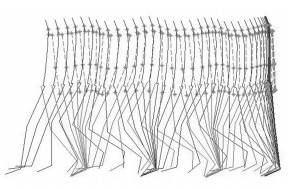
 下载:
下载:
